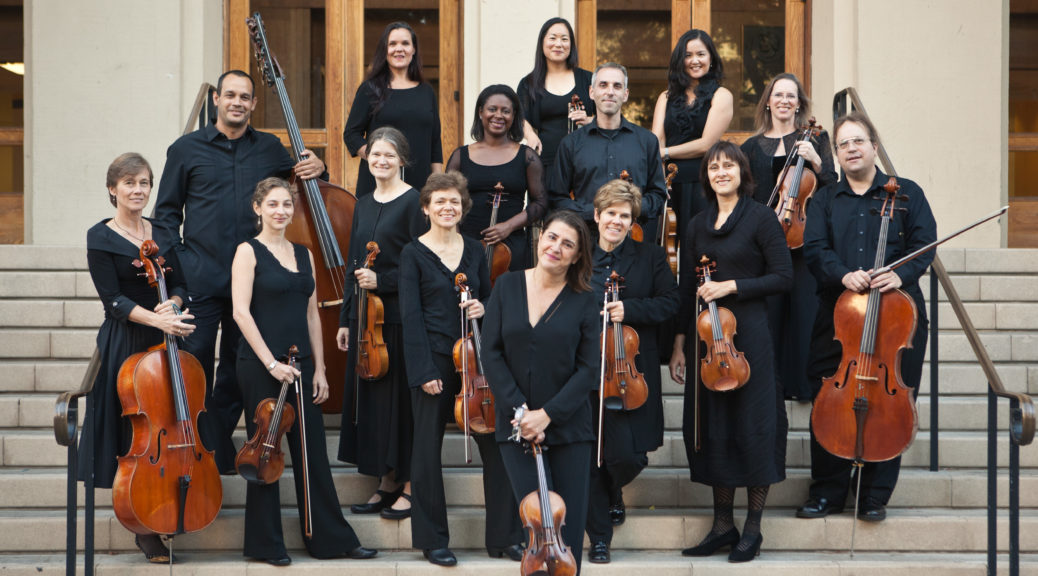
NADJA’S FAREWELL
For a grand finale, the New Century Chamber Orchestra served up a savory mix of post-millennium musical canapes. Call it Nadja’s antipasto.
Leaving after nine hyperactive years as leader, violinist Nadja Salerno-Sonnenberg dished up a night of excerpts from NCCO premieres logged during her tenure. And what could be more appropriate? Within its rather short seasons, the NCCO serves the Bay Area a rich menu of new works. And all indications are that whoever is appointed to succeed her as leader/violinist/music director will continue this forward-looking tradition.
The use of a leader/violinist/music director is a non-podium tradition going back to Corelli, Vivaldi and the baroque, less encountered nowadays. Only the NCCO doesn’t feast on Corelli, Vivaldi as much as on Corigliano, Higdon and other living creative musicians.
The NCCO, now turning 25, is unique. It is a versatile all-strings ensemble of a score of players performing new and old scores, between the dimensions of chamber music and symphony orchestras. The personnel are about three-quarters women, whether led by men (like co-founder Stuart Canin) or women (like Krista Bennion Feeney). Their performances hew to a high standard, playing their four programs in four Bay Area venues year after year.
Going on to a teaching post at Loyola University New Orleans, Salerno-Sonnenberg leaves an enviable legacy for the successor, who could be one of the guests popping up next season.
Salerno-Sonnenberg has brought an irrepressible high energy to the group. It was seasoned with her start in Italy, her precocious development early on back east, and her up-and-down concerto-and-recital career in between. She doesn’t just serve up music, she devours it with relish. And the ensemble of 14 women and five men plays extremely well, with spirit.
You have to credit Salerno-Sonnenberg for bringing so many women composers to the forefront. The day is long past when they specialized in salon music; they write much like the men, and I defy any one nowadays to sit blind-folded and tell which works are by which gender. Clearly, the star of the women composers is now in the ascendancy, at least in America.
Although the week’s opening program leaned toward Old Americana, there were memorable exceptions, like Jennifer Higdon’s “Strings” from the concerto for orchestra. Here Higdon brings on complex rhythmic patterns like 5 beats to the measure, and notable syncopation. Michael Daugherty’s animated “Strut” similarly marched to a different drummer so to speak, with its passionate orchestra in torment, or in ecstasy, or halfway in between. The piece is loud and fast-moving, with waterfall-like glissandi in the accompaniment, and Nadja providing a strong violin solo.
Ellen Taafe Zwilich, 77, who had been the first woman ever to receive aPulitzer in music, offered her Prologue and Variations, an unsettled work with dark colors. It’s music of am ambivalent soul, a taut piece of soul-searching with a sustained pulse.
The Soviet-born émigré Lera Auerbach had “Primera luz” (First Light), and Derek Bermel’s “Memorations.” These were played as if linked, with alluring juxtapositions of high-low extremes of notes, and then sensual harmonies of what could be a barcarolle turned to serenade.
Americana permeated the remaining works, particularly in the written-for-TV “Song of the Liberty Bell” by Mark O’Connor. Clarice Assad’s “Impressions” featured virtuosic writing and a porrtion of blues notes for each string section, spotlighted separately. I was frustrated with the rags by William Bolcom. Strings are fine and dandy, but what are rags without, say, a piano, a clarinet, maybe percussion? It comes off like Music Minus One.
New Century Chamber Orchestra, farewell concerts of leader Nadja Salerno-Sonnenberg, May 16, 18, 20. Herbst Theatre, S.F. For NCCO info: (415) 357-1111, or go online.